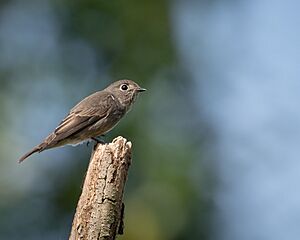Dark-sided flycatcher facts for kids
Quick facts for kids Dark-sided flycatcher |
|
|---|---|
 |
|
| In Kaeng Krachan NP, Petchburi, Thailand | |
| Conservation status | |
| Scientific classification | |
| Genus: |
Muscicapa
|
| Species: |
sibirica
|
The dark-sided flycatcher (Muscicapa sibirica) is a small, brownish bird. It belongs to a group of birds called Old World flycatchers. These birds are known for catching insects while flying. You can find the dark-sided flycatcher in many parts of Asia. Birds from the northern areas fly south for the winter. People sometimes call it the Siberian flycatcher or sooty flycatcher.
Contents
Discovering the Dark-sided Flycatcher
Scientists give every animal a special two-part name. This helps everyone know exactly which animal they are talking about. The dark-sided flycatcher's scientific name is Muscicapa sibirica.
Who Named This Bird?
A German scientist named Johann Friedrich Gmelin first officially described this bird in 1789. He put it in the group of flycatchers called Muscicapa. Gmelin learned about the bird from an English scientist, John Latham. Latham had written about a "Dunn flycatcher" he found near Lake Baikal in Siberia.
Different Kinds of Dark-sided Flycatchers
Scientists have found four slightly different types, or subspecies, of the dark-sided flycatcher:
- M. s. sibirica: Found in central and southern Siberia, Korea, and Japan.
- M. s. gulmergi: Lives in northeast Afghanistan and the northwest Himalayas.
- M. s. cacabata: Found from the central Himalayas to southern Tibet and northeast India.
- M. s. rothschildi: Lives in central and southern China, northern Myanmar, and northwest Vietnam.
What Does the Dark-sided Flycatcher Look Like?
This small bird is about 13 to 14 cm (5.1 to 5.5 in) (about 5 inches) long. It has dark grey-brown feathers on its back and wings. You might notice a light bar on its wings.
Feathers and Features
Its chest and sides have streaky dark grey-brown marks. It has a white throat with a dark stripe below its eye, making a half-collar. The middle of its belly is white. Its beak is short and dark, and its feet are black. It has large eyes with a white ring around them. Both male and female birds look alike. Young birds have light spots on their backs and mottled chests.
How to Tell it Apart
The dark-sided flycatcher looks a bit like other flycatchers. It's different from the Asian brown flycatcher because that bird has plainer, lighter feathers underneath. It also looks different from the grey-streaked flycatcher, which has clear grey streaks on its white belly. The dark-sided flycatcher's wing feathers stick out a bit more than the Asian brown flycatcher's.
Bird Calls and Songs
Its song is a series of thin, high-pitched sounds. It includes trills and whistles. When it calls, it makes a metallic tinkling sound.
Where Do Dark-sided Flycatchers Live?
These birds live in many parts of Asia. They prefer forests and woodlands. You might also see them in parks or gardens. They often live in mountains, sometimes as high as 4000 meters (about 13,000 feet) above sea level.
Breeding Areas
The M. s. sibirica type breeds in southeast Siberia, Mongolia, northeast China, North Korea, and Japan. Other types breed in places like western China, Myanmar, Afghanistan, and the Himalayas.
Winter Homes and Travelers
When winter comes, many dark-sided flycatchers fly south. They spend winter in places like northeast India, Bangladesh, southern China, Taiwan, and South-east Asia. This includes islands like Sumatra, Java, Borneo, and the Philippines. Sometimes, a few birds get lost and fly far away. They have been seen in places like Alaska, Iceland, and Bermuda!
How Do Dark-sided Flycatchers Behave?
Like other flycatchers, these birds are clever hunters. They like to sit on an open branch and wait. When an insect flies by, the bird quickly flies out to catch it in mid-air.
Nesting and Eggs
The female bird builds a nest that looks like a cup. She usually builds it on a tree branch, sometimes up to 8 meters (about 26 feet) high. Sometimes, she might build it in a hole. She lays three to four eggs. The female sits on the eggs to keep them warm, and the male bird brings her food.


